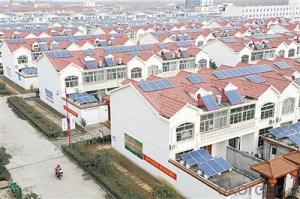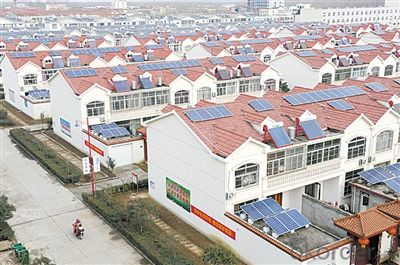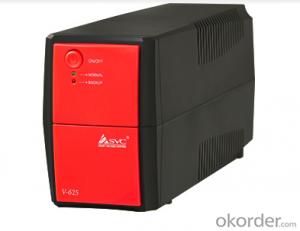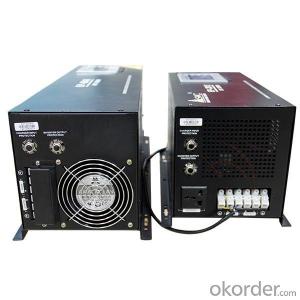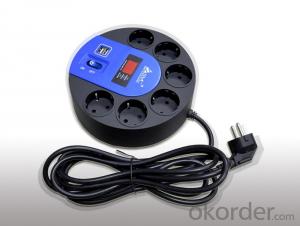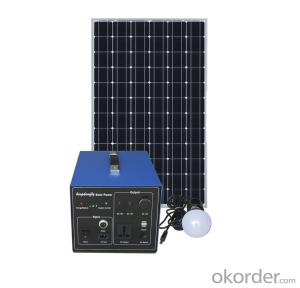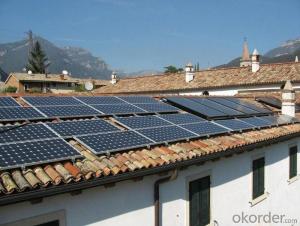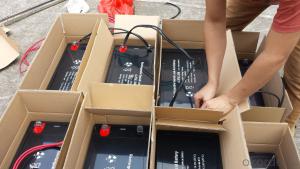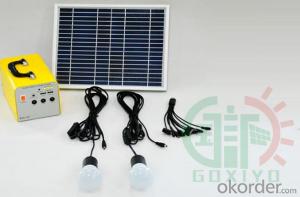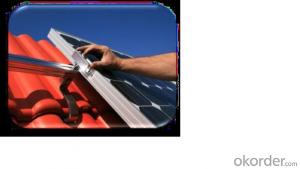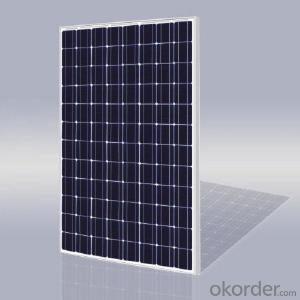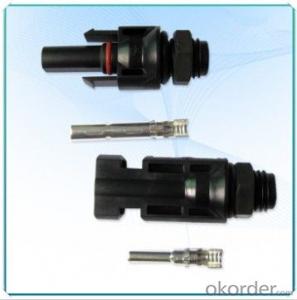Sharpe Solar Energy Systems - Roof Solar Power System Hot Sale Good Design
- Loading Port:
- Shanghai
- Payment Terms:
- TT or LC
- Min Order Qty:
- 500 watt
- Supply Capability:
- 2000000 watt/month
OKorder Service Pledge
OKorder Financial Service
You Might Also Like
| Quick Details | |||||
| Specification: | Normal | Application: | Home | Output Voltage (V): | AC110V/220V |
| Load Power (W): | 3KW | Solar Power (W): | 3KW | Work Time (h): | 48 |
| Cables: | 50m | Solar Panel Rack: | Optional | Battery Capacity: | 12V/200AH*8pcs |
| Controller Voltage: | 48V | Inverter Output Voltage: | AC220V/110V | Efficiency: | 90% |
| Inverter: | DC48V | Rated Output Capacity: | 3000W | Solar Panel Power: | 250w*12pcs |
| Solar Panel Type: | Crystalline Silicon PV Module | ||||
| Packaging & Delivery | |||||
| Packaging Detail: | using carton or wooden box as per customer's requirement. | ||||
| Delivery Detail: | within 10~30 days for shipment depending on order quantity | ||||
Excellent battery backup 300W to 10KW off grid solar system with grid power switch
Anern Advantage:
1) Over 10 year experience in clean energy line, business covering solar street light, solar garden light, off grid
solar system and on grid solar power system, etc;
2) Exporting for worldwide, with satisfied clients more than 50 countries;
3) Competitive price, excellent service, integrated certificate system;
We supply CE, RoHS certificates if you need
Welcome to visit our factory at any time.
Solar system advantages:
1. CE, ROHS approved.
2. High conversion efficiency, high-transmission rate.
3. Energy saving, environmental-friendly.
4. Advanced technology, strict quality control system.
5. Easy installation, safe operation, free maintenance.
6. Low MOQ, fast delivery time, long service life
Specifications:
| Ref No. | OFF-SGHP-3KW | |
| System Basic Information | Solar Panel Rated Output Power | 3KW |
| Suitable for Max Daily Power Consumption | 10KWH | |
| Rated Output AC Capacity | 3KW | |
| Solar panel | ||
| Type | Crystalline Silicon PV Module, A-class | 12pcs |
| Max Power | 250W | |
| Vmp | 30.5V | |
| Size | 1655*992*45mm | |
| Weight | 22.5kg/pc | |
| 25 years power output guarantee (Note: 2pcs panels connect in series) | ||
| Controller | ||
| Voltage | 48V | 1pc |
| Current | 60A | |
| Warranty | 1 year | |
| PWM high-efficiency charging controller, LED display, intelligent control; Temperature compensation, various protections. | ||
| Circuit Breaker | Used for protection of controller, installed between PV array combiner and controller | 1pc |
| Inverter | ||
| Input Voltage | DC48V | 1set |
| Output Voltage | AC220V/110V 1-phase | |
| Frequency | 50/60Hz | |
| Efficiency | 90% | |
| Note: This inverter provides grid power switch and battery charging functions. | ||
| Battery | ||
| Capacities | 12V/200AH per piece | 8pcs |
| Service life | 5 to 6 years | |
| Warranty | 3 years | |
| Solar panel rack | Flat-roof type mounting rack, steel material, anti-rust treatment | 1 set |
| (Other types of racks can be customized as per client's requirement) | ||
| Cable | 50m | |
| Connectors | 3-terminal connectors, used for panels connection in parallel | 6 set |
Product features:
1. Off grid solar power system is mainly used for application with relatively-small power consumption, and the areas have no grid network coverage, or grid power is unstable or outage condition.
2. It’s composed of solar panels, hybrid solar inverter, battery bank, solar panel mounting racks, and other accessories required fora complete home solar power system.
3. The battery bank gives a stable power output to the solar inverter which converts DC to AC to power loads, and provides power backup in rainy or cloudy days.
4. The solar panels generate electricity at daytime and charge the battery bank .
5. The off grid home solar power system provides grid power bypass in case of battery power shortage when sunshine is not enough.
6. All the off grid home solar power system configurations are worked out by scientific calculation and design.
Features:
1.Environmental protection
2.Energy-saving products
3.Portable
4.easily use
Advantages:
1.Safety and easy installation,Plug and play systems;
2.Good quality panel to ensure the high efficiency and long life needs;
3.Solar Automatic lighting controller :with adjustable run times, over-current protection;
4.Solar Batteries: Maintenance free, long life batteries
5.Lighting Source: LED lamp /Lantern (Fixed/Movable)
7.Flexible designs per client requests;
Using of scope:
It is very good for indoor use where there is shortage of electricity and for outdoor activities such as picnicking, fishing and camping. It is an ideal tool for Motor Mechanics, Farm House and small shop owners such as Hairdressers, Barbers, Cobblers, Tailors and Kiosk keepers.
- Q: Can solar energy systems be used for powering water treatment plants?
- Yes, solar energy systems can be used for powering water treatment plants. Solar power can be harnessed through photovoltaic panels or solar thermal systems to generate electricity or heat, which can be utilized in various processes of water treatment, such as pumping, filtration, disinfection, and desalination. Solar energy offers a sustainable and renewable source of power, reducing the reliance on fossil fuels and lowering operational costs for water treatment facilities.
- Q: How does the efficiency of solar panels vary with different weather conditions?
- The efficiency of solar panels can vary significantly depending on the weather conditions. Solar panels convert sunlight into electricity, and therefore, their efficiency is directly affected by the amount of sunlight they receive. On a clear and sunny day, solar panels operate at their peak efficiency since they receive the maximum amount of sunlight. The direct sunlight allows for optimal conversion of solar energy into electricity, resulting in higher efficiency. However, during cloudy or overcast days, the efficiency of solar panels decreases. This is because clouds block a significant portion of the sunlight, reducing the amount of energy available for conversion. While solar panels can still generate electricity under cloudy conditions, their efficiency is considerably lower compared to sunny days. Temperature is another weather factor that affects solar panel efficiency. Contrary to popular belief, solar panels actually work more efficiently in cooler temperatures. As the temperature increases, the performance of solar cells decreases due to a phenomenon called the temperature coefficient. High temperatures reduce the voltage output of solar panels, leading to lower efficiency. Rain or snowfall can also impact the efficiency of solar panels, although the effect is relatively minimal. Rain can temporarily decrease the efficiency by reducing the amount of sunlight reaching the panels, but once the rain stops, they return to their normal efficiency. Snow, on the other hand, can cover the panels and prevent sunlight from reaching them, resulting in a temporary loss of efficiency until the snow is cleared. In summary, the efficiency of solar panels varies with different weather conditions. Clear and sunny days provide optimal conditions for maximum efficiency, while cloudy or overcast days result in decreased efficiency. Temperature fluctuations can also impact the performance of solar panels, with higher temperatures leading to lower efficiency. Rain and snow can temporarily reduce efficiency, but their overall impact is relatively minor.
- Q: How does a PV system convert sunlight into electricity?
- A PV (photovoltaic) system converts sunlight into electricity through the use of solar panels. These panels contain photovoltaic cells made of semiconducting materials, such as silicon. When sunlight hits these cells, it excites the electrons, causing them to flow and create an electric current. This direct current (DC) is then converted into alternating current (AC) using an inverter, which can be used to power homes, businesses, or other electrical devices.
- Q: Can solar energy systems be used for powering agricultural irrigation systems?
- Yes, solar energy systems can be used for powering agricultural irrigation systems. Solar panels can convert sunlight into electricity, which can be used to power pumps and other irrigation equipment. This helps to reduce reliance on conventional energy sources and provides a sustainable solution for water management in agriculture.
- Q: What are the different mounting options for solar energy systems?
- Solar energy systems can be mounted in various ways, depending on the installation site's requirements and limitations. Some common mounting options include: 1. Roof-mounted systems: The most popular choice for residential installations involves installing solar panels on the roof using specialized brackets. Different types of roofs, like asphalt shingles, metal roofs, or tile roofs, can accommodate these systems. They are space-efficient and have minimal impact on the building's appearance. 2. Ground-mounted systems: These solar systems are placed on the ground with the help of metal frames or poles. Ideal for large residential or commercial installations with ample land, they offer flexibility in panel orientation and tilt angle, maximizing exposure to sunlight. 3. Carport or canopy-mounted systems: Solar panels can be installed on carports or canopies, delivering both clean energy generation and shade/protection for vehicles or outdoor spaces. These systems are commonly found in commercial or public parking lots, contributing to a site's reduced carbon footprint. 4. Pole-mounted systems: In certain cases where space is limited or ground or roof installations are not feasible, solar panels can be mounted on poles or trackers. This optimizes sunlight exposure throughout the day and is often used in specific areas. 5. Integrated or building-integrated systems: Building-integrated photovoltaics (BIPV) allow solar panels to seamlessly become part of a building's structure, replacing conventional materials like windows, façades, or roof tiles. These systems offer architectural flexibility and are commonly used in new construction or retrofit projects where aesthetics are prioritized. Each mounting option has its own advantages and considerations, such as cost, space availability, aesthetics, and adherence to local regulations. Assessing the specific needs and limitations of the site is crucial in determining the most suitable mounting option for a solar energy system.
- Q: Can solar energy systems be used in areas with high levels of snowfall?
- Yes, solar energy systems can be used in areas with high levels of snowfall. While snow can reduce the amount of sunlight reaching the solar panels, it does not render them completely ineffective. Modern solar panels are designed to be efficient in various weather conditions, including snow. Additionally, the angle and tilt of the panels can be adjusted to shed snow and maximize sunlight absorption. In snowy regions, it is common to mount solar panels at steeper angles to help snow slide off. Furthermore, advancements in solar technology, such as the use of anti-reflective coatings and self-cleaning mechanisms, help prevent snow buildup and maintain optimal performance. It's worth noting that while snow can temporarily reduce energy generation, solar energy systems can still produce electricity even in cloudy conditions. Overall, with proper planning and maintenance, solar energy systems can be effectively utilized in areas with high levels of snowfall.
- Q: Can solar energy systems be used in powering restaurants or food chains?
- Solar energy systems are a viable option for providing power to restaurants and food chains. They are an eco-friendly and sustainable source of energy that can effectively reduce operational expenses and minimize the environmental impact of these establishments. Solar panels can be installed on rooftops or in open areas to capture sunlight and convert it into electricity, which can then be utilized for various functions within restaurants, including lighting, refrigeration, cooking equipment, and air conditioning. By adopting solar power, restaurants and food chains not only save on their energy bills but also showcase their dedication to sustainability and environmentally-conscious practices. Moreover, certain governments offer incentives and tax advantages to businesses that opt for solar energy systems, making it an even more appealing choice. All in all, solar energy systems are a practical and eco-friendly solution for powering restaurants and food chains.
- Q: Can solar energy systems be installed on recreational vehicles?
- Yes, solar energy systems can be installed on recreational vehicles. These systems are specifically designed to provide power to RVs and can help owners generate electricity for appliances, lighting, and other electrical needs while on the road or camping.
- Q: What is the difference between a solar thermal system and a photovoltaic system?
- Solar energy systems come in different forms, such as solar thermal and photovoltaic systems, each serving distinct purposes. When it comes to heating, a solar thermal system takes the lead. It operates by harnessing the sun's energy and directly heating water or air. This is achieved through the use of solar collectors, which absorb sunlight and convert it into heat. The heated water or air can then be utilized for space heating, water heating, or even powering turbines to generate electricity. These systems are commonly utilized in residential, commercial, and industrial settings to provide efficient heating solutions. On the other hand, photovoltaic systems, often referred to as solar panels, are primarily designed to generate electricity. They make use of photovoltaic cells, typically composed of silicon, to directly convert sunlight into electrical energy through the photovoltaic effect. These cells are interconnected within solar panels, and multiple panels can be combined to create a complete photovoltaic system. The electricity produced by a photovoltaic system can be utilized to power electrical devices, appliances, or even be fed into the grid to offset energy consumption. To summarize, the key distinction between a solar thermal system and a photovoltaic system lies in their respective functions. While solar thermal systems focus on heating applications by directly utilizing the sun's energy to heat water or air, photovoltaic systems are specifically designed to generate electricity through the conversion of sunlight into electrical energy using solar panels.
- Q: Can a solar energy system withstand extreme weather conditions?
- Certainly, extreme weather conditions pose no challenge for a solar energy system. Solar panels boast a sturdy design that enables them to endure diverse weather phenomena, such as scorching heat, freezing cold, fierce winds, heavy downpours, and even snowfall. These panels are crafted with tempered glass and often undergo rigorous testing to ensure their resilience against hailstorms or excessive snow loads. Moreover, solar panels are securely installed to withstand powerful gusts and are engineered to resist corrosion. In essence, although extreme weather conditions may slightly affect solar energy production, solar energy systems are purposefully constructed to persist and function optimally in various weather conditions.
Send your message to us
Sharpe Solar Energy Systems - Roof Solar Power System Hot Sale Good Design
- Loading Port:
- Shanghai
- Payment Terms:
- TT or LC
- Min Order Qty:
- 500 watt
- Supply Capability:
- 2000000 watt/month
OKorder Service Pledge
OKorder Financial Service
Similar products
Hot products
Hot Searches
Related keywords
